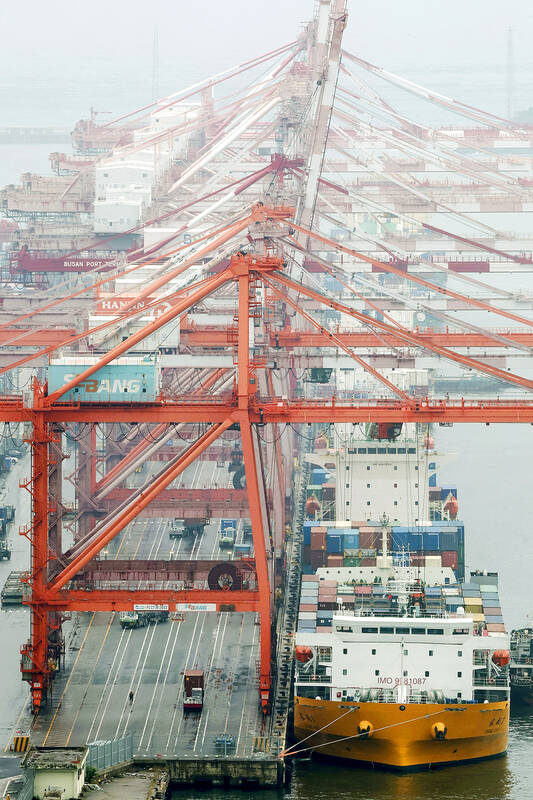South Korean exports offered an early sign of improvement in global trade after their first year-on-year gain since last summer.
Preliminary trade data showed a 5.3 percent gain in exports in the first 20 days of this month from a year earlier for the first increase since August last year, a possible sign that a slowdown in world demand is starting to ease.
The rise was largely driven by gains in auto and shipping-related exports, while semiconductor exports continued to drop.

Photo: EPA-EFE
As a key provider of chips and smartphones for the global economy, South Korea’s export data offer one of the earliest pulse checks on the strength of international trade and tech-sector demand.
While the figures were encouraging, it is too early to gauge how fast any recovery might be, Australia and New Zealand Banking Group economist Krystal Tan (譚恩) said.
“But it does look like we’re nearing a bottom,” Tan said.
An improvement in the nation’s shipments can be a leading indicator for the wider trend, although economists warn against drawing concrete conclusions from an incomplete set of monthly figures.
“The data indicates global trade may have bottomed out, but whether it is set for a full-on recovery will be something to be watched,” said Moon Jung-hiu, economist at KB Kookmin Bank in Seoul.
Gains were led largely by shipments to the US, steady demand for automobiles and a jump in shipping-related demand.
Exports to the EU and Hong Kong also advanced on a year-on-year basis, although shipments to China were down again.
The results fit in with a picture of a US economy showing resilience, despite a string of rate hikes, while China’s recovery continues to disappoint even as policymakers there ramp up stimulus to try and restore momentum.
A full recovery in global trade depends largely on China — a major engine of the world economy — and a resurgence in appetite for chips, which go into everything from vehicles to electronic devices.
The figures have to be taken “with a grain of salt and can be seen as US exports stabilizing rather than a surge,” Tan said.
Even with the gain, overall exports were still about 18 percent lower from their 20-day peak in March last year.
A measure of average daily exports, which removes potential distortions from changes in the number of working days, also showed that shipments were not as strong as the headline figure indicated.
The average inched down 2 percent, although that was the smallest fall since exports began to drop last year.
The 20-day data showed that auto exports more than doubled. Shipping-related demand, a factor that sometimes skews monthly figures, was also up by more than 100 percent.
While semiconductor exports fell 23.5 percent, the drop eased compared with last month’s full month figures.
Overall imports declined 11.2 percent, resulting in a trade deficit of US$1.61 billion.

PROTECTION: The investigation, which takes aim at exporters such as Canada, Germany and Brazil, came days after Trump unveiled tariff hikes on steel and aluminum products US President Donald Trump on Saturday ordered a probe into potential tariffs on lumber imports — a move threatening to stoke trade tensions — while also pushing for a domestic supply boost. Trump signed an executive order instructing US Secretary of Commerce Howard Lutnick to begin an investigation “to determine the effects on the national security of imports of timber, lumber and their derivative products.” The study might result in new tariffs being imposed, which would pile on top of existing levies. The investigation takes aim at exporters like Canada, Germany and Brazil, with White House officials earlier accusing these economies of

EARLY TALKS: Measures under consideration include convincing allies to match US curbs, further restricting exports of AI chips or GPUs, and blocking Chinese investments US President Donald Trump’s administration is sketching out tougher versions of US semiconductor curbs and pressuring key allies to escalate their restrictions on China’s chip industry, an early indication the new US president plans to expand efforts that began under former US president Joe Biden to limit Beijing’s technological prowess. Trump officials recently met with their Japanese and Dutch counterparts about restricting Tokyo Electron Ltd and ASML Holding NV engineers from maintaining semiconductor gear in China, people familiar with the matter said. The aim, which was also a priority for Biden, is to see key allies match China curbs the US

Teleperformance SE, the largest call-center operator in the world, is rolling out an artificial intelligence (AI) system that softens English-speaking Indian workers’ accents in real time in a move the company claims would make them more understandable. The technology, called accent translation, coupled with background noise cancelation, is being deployed in call centers in India, where workers provide customer support to some of Teleperformance’s international clients. The company provides outsourced customer support and content moderation to global companies including Apple Inc, ByteDance Ltd’s (字節跳動) TikTok and Samsung Electronics Co Ltd. “When you have an Indian agent on the line, sometimes it’s hard

‘SACRED MOUNTAIN’: The chipmaker can form joint ventures abroad, except in China, but like other firms, it needs government approval for large investments Taiwan Semiconductor Manufacturing Co (TSMC, 台積電) needs government permission for any overseas joint ventures (JVs), but there are no restrictions on making the most advanced chips overseas other than for China, Minister of Economic Affairs J.W. Kuo (郭智輝) said yesterday. US media have said that TSMC, the world’s largest contract chipmaker and a major supplier to companies such as Apple Inc and Nvidia Corp, has been in talks for a stake in Intel Corp. Neither company has confirmed the talks, but US President Donald Trump has accused Taiwan of taking away the US’ semiconductor business and said he wants the industry back